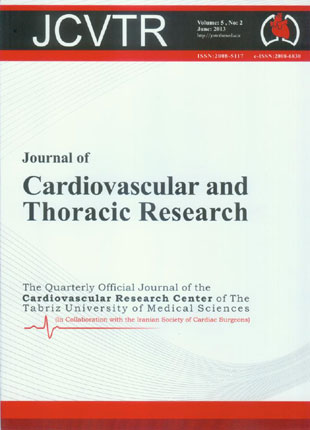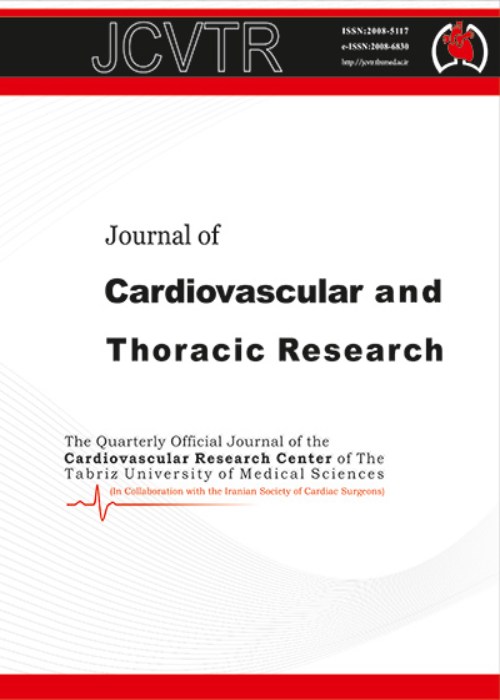فهرست مطالب

Journal of Cardiovascular and Thoracic Research
Volume:5 Issue: 2, Jul 2013
- تاریخ انتشار: 1391/12/17
- تعداد عناوین: 9
-
-
Pages 41-44IntroductionThe severity of coronary artery stenosis which leads to myocardial infarction (MI) has been a matter of controversy. Historical data are in favor of mild luminal stenosis (<50% diameter stenosis) while recent studies suggest hemodynamicallysignificant coronary stenosis as the main substrate for subsequent MI. Also, mechanical stress resulted from coronary artery movement (CAM) may be responsible for plaques rupture. In this study, we evaluated the severity of plaques leading to MI and common CAM patterns in the involved coronary segments.MethodsIn a cross-sectional descriptive-analytical study, on patients with acute ST-segment myocardial infarction (STEMI) undergoing coronary angiography, the relationship between coronary artery movement type and stenosis severity with acute MI was evaluated. Lesions with stenosis diameter greater than 50 percent were defined as moderate and those equal or higher than 70% were defined as severe stenosis. Three different patterns of coronary artery motion including compression, bending and displacement types were evaluated in segments with culprit lesion.ResultsOne hundred and sixty two patients were enrolled. Ninety patients (55.6%) were male and 72 (44.4%) were female. Mean age of the patients was 60.56±13.43 years. In terms of Infarct related lesions (IRLs), 86% of the cases had at least moderate stenosis and in 67%, severe stenosis was present. More than 50% stenosis was found in all patients with anterior STEMI involving LAD. Among three types of coronary motion patterns, compression pattern was significantly higher in LAD (P<0.001), RCA (P<0.001), Diagonal artery (P<0.001) and OM branch (P=0.044), but not in proper LCX (P=0.307).ConclusionMost of the lesions leading to myocardial infarction have a diameter stenosis of at least 50% and mainly are located in the coronary segments with compression movement pattern.Keywords: Myocardial Infarction Coronary Artery Movement Coronary Plaque
-
Pages 45-49IntroductionTo examine whether or not off-pump CABG (Coronary Artery Bypass Reduce) reduces the incidence of AF after cardiac surgery.MethodsThe study was carried out in 939 consecutive coronary artery disease patients with sinus rhythm from which 383 patients underwent off-pump CABG, and 556 patients were operated through on-pump CABG. All patients were monitored postoperatively during intensive care unit (ICU) stay. Then, the incidence and predictive risk factors of post operative AF (POAF) in two groups were determined and compared with each other.ResultsOverall, the mean age of the patients was 56.0±12.8 years with 234 patients (24.9%) being older than 65 years. POAF developed in 38 patients (9.9%) of the offpump and in 93 patients (16.7%) of the on-pump CABG. There was significant difference between two groups when considering the incidence of POAF (P=0.002). Among preoperative risk factors, age>65 years had a significant association with the incidence of AF in both groups. This study also showed that most of the POAF cases converted to sinus rhythm after treatment. Moreover, these finding demonstrated that conversion to sinus rhythm is significantly more probable in off-pump group (P=0.006).ConclusionA reduced prevalence of POAF could be observed in patients with offpump as compared with on-pump techniques. Furthermore, conversion to sinus rhythm in off-pump group was significantly more probable than on-pump group.Keywords: Off, pump CABG On, pump CABG Postoperative Atrial Fibrillation Risk Factor
-
Pages 51-54IntroductionVarious methods have been recommended to prevent hemodynamic instability caused by propofol induction. Current study evaluates hemodynamic effects of ketamine and propofol in comparison to etomidate and propofol during anesthesia induction.MethodsSixty-two patients over 50 years old undergoing elective surgeries were randomly assigned to ketamine + propofol (ketofol) (n=30) and etomidate + propofol (etofol) (n=32) groups. Patients in ketofol group were induced with ketamine 0.75 mg/ kg and propofol 1 mg/kg. In etofol group, induction was performed with etomidate 0.2 mg/kg and propofol 1 mg/kg. Hemodynamic states before and after induction, first, third and sixth minutes after intubation were measured and compared between groups.ResultsThere was no difference between groups in systolic (SAP), diastolic (DAP) and mean arterial pressure (MAP), heart rate (HR) and blood oxygen saturation (SaO2). There was significant decrease in SAP, DAP and MAP after induction and 6 minutes after intubation and in HR after induction than values before induction. There was significant increase in SaO2 in all evaluated periods than before induction in etofol group; however, the difference in ketofol group was not significant.ConclusionBoth methods of induction -ketamine + propofol and etomidate + propofolare effective in maintaining hemodynamic stability and preventing hemodynamic changes due to propofol administration.Keywords: Ketamine Etomidate Intubation Hemodynamic
-
Pages 55-59IntroductionAtrial fibrillation (AF) is the most common sustained cardiac arrhythmia in patients with mitral valve disease affecting 50% of patients undergoing mitral valve surgery, contributing to increased risks of systemic embolization, anticoagulant- related hemorrhage and mortality. The maze procedure is an effective way to treat AF. Over the last several years, cryoablation was substituted for atrial incision in many reports to simplify the maze procedure. However, few studies have been carried out to evaluate the results of cryoablation surgery. In the present study we evaluated the results of this procedure.MethodsIn this cross sectional study, 47 AF patients were treated with Cryo-Maze surgery method. Rhythm assessment using electrocardiographic and echocardiographic survey was performed in all patients before surgery, during the patients’ hospital stay, on discharge and after six months.ResultsSurvival rate of the studied patients at six months was 93.6%. Sinus rhythm restoration rate in Cryo-Maze patients was 72.1% on discharge and 76.7% six months after their operation.ConclusionThe present study revealed that Cryo-Maze procedure is an effective and safe therapeutic modality in AF while normal sinus rhythm can be achieved in patients following this intervention.Keywords: Maze Surgery Atrial Fibrillation Cryoablation
-
Pages 61-65IntroductionAtherosclerosis is one of the inflammatory underlying disease associated by oxidative stress and thrombotic agents. This study aimed to evaluate the potential role of cupper oxidized low-density lipoprotein (OxLDL) and thrombin for inducing mitogen activated protein kinases (MAPKs) in platelets.MethodsPhosphorylation of P38MAPK, Jun N-terminal Kinase (JNK), and Extracellular signal-regulated kinases (ERK1/2) and P-selectin expression were determined in lysates of washed human platelets pretreated with low doses of thrombin and cu2+-OxLDL By Enzyme-linked immunosorbent assay (ELISA). Pharmacological inhibition was performed by SB203580, PD980559 and SP6000125 for P38MAPK, ERK1/2 and JNK activity, respectively. The ratio of phosphorylated to total protein was used for normalizing the phospho proteins contents of cells.ResultsOxLDL and thrombin significantly and differentially increased P-selectin expression (P<0.05), P38MAPK (P<0.05) and c-JNK (P<0.05) and ERK1/2 (P<0.05) phosphorylation in platelets. SB 203580 and SP6000125 significantly decreased P-selectin expression in both oxidative (P<0.05) and thrombotic (P<0.05) activated platelets.ConclusionOur results indicated that MAPK inhibitors can reduce atherothrombotic events via alterations in P-selectin expression suggesting that these inhibitors may be useful in the inhibition of atheroma development.Keywords: Atherosclerosis C, Jun N, terminal Kinase Extracellular Signal, regulated Kinase P38, Mitogen Activated Protein Kinase P, selectin
-
Pages 67-70IntroductionCardiovascular disease (CVD) counts for a major portion of morbidity and mortality globally mostly accompanied by lipid abnormalities. Being at increased risk of cardiac injury, critically ill patients suffer from various lipid disorders. Lipid homeostasis has been efficiently restored by the introduction of probiotics. The aim of this trial was to determine the effect of probiotics on inflammation, antioxidant capacity and lipid peroxidation in critically ill patients.MethodsForty patients admitted to the intensive care unit were randomized to receive placebo or probiotic for 7 days. Serum levels of triglyceride (TG), total cholesterol, HDL-C, LDL-C and high- sensitivity C-reactive protein (hs-CRP) were measured before initiation of the study and on the 7th day.ResultsThere was a significant difference between two groups regarding the levels of TG, HDL and hs-CRP at the end of the study (P= 0.043, <0.001 and 0.003, respectively); however, there was not a significant difference in total cholesterol and LDL-C levels.ConclusionAdministration of probiotics in critically ill patients reduced the levels of TG and hs-CRP and increased HDL-C levels. However, no significant change was detected in levels of total cholesterol or LDL-C.Keywords: Probiotic Critically Ill Lipid Profile Cardiovascular Disease
-
Pages 71-72Cardiac rhabdomyomas are often associated with tuberous sclerosis in infants. We report a 5 month old child presented with a tumor in the right ventricle and echocardiography features of rhabdomyoma. Both the child and her father had cutaneous features of tuberous sclerosis. In the absence of features of congestive heart failure, surgery is rarely required.Keywords: Rhabdomyoma Tumor Right Ventricle Tuberous Sclerosis
-
Pages 73-75Double left anterior descending coronary artery originating from left main coronary stem and right coronary artery is a rare congenital coronary anomaly. In this case report, we are describing a patient with double left anterior descending coronary artery, one with normal origin, and the other originating from the right coronary artery. To the best of our knowledge, there are only a few reports resembling such case.Keywords: Coronary Artery Anomaly Left Anterior Descending Coronary Artery Coronary Artery Origination
-
Pages 77-80Primary pericardial malignant mesothelioma is an extremely rare tumor even among all mesotheliomas with about 350 cases reported in the literature so far. Typically, it has an insidious presentation, with nonspecific signs and symptoms, and usually results in constrictive pericarditis, cardiac tamponade or congestive heart failure through either a massive effusion or direct tumurous constriction or invasion to the heart. With the exception of several case reports, the outcome is uniformly dismal and patients typically die within six months of diagnosis. We report a 24 year old male with long history of pleuretic chest paint and admissions with a diagnosis of idiopathic pericarditis, eventually presenting with increasing symptoms of heart failure and a large mobile ball like mass in the heart at echocardiographic and computed tomography studies. At operation, an atypical invasive cardiac tumor was discovered. Complete resection of the tumor was impossible and the patient died from progression of the disease 4 months later.Keywords: Cardiac Tumor Pericardial Mesothelioma Pericardial Effusion Pericardiectomy


